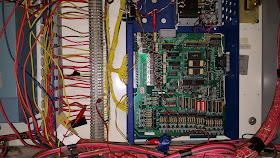We had a question from a building owner who modernized
their elevator equipment on how fireman’s service operation functioned. All new
elevators modernized or new construction will have fireman’s service and
automatic recall. I had intended on
doing a very thorough post but non elevator life got in the way and I will
revise the posting when I get a few moments.
But this is a good start.
Phase I – Fireman’s recall phase I is a key switch located
in the lobby of a building, it could be in the hall button fixture or mounted
in the door frame. This key switch when
activated will call the elevator to the main floor[where the key switch is] and
the doors will open. This is meant to be
used by emergency service personnel only.
Phase II – The phase II key switch is in the elevator and
is for the emergency personnel to operate the elevator without any
interruption.
Automatic recall – Automatic recall is when a fire recall
device(s)[most of the times they are smoke detectors but the City of Chicago
allows[ed] sprinkler flow switches] go off, the elevator will go to the main
landing or alternate landing depending on which device goes off. If a device on the 3rd landing
goes off[assuming it is not the main landing] the elevator will go to the main
landing[most times the 1st floor or lobby] and the doors will open
and not allow operation of the elevator.
If a device goes off on the main landing the elevator will go to an
alternate floor and the doors would open and not allow operation. The purpose of this feature is to send the
elevator away from the fire floor for everyone’s safety.
Exercising requirements – The elevator code requires
FEO[Fire Fighters Emergency Operation] to be “exercised” once each month and
documented. If your elevator company
isn’t coming once a month the building must have someone trained in this
exercise.
Phase I Bypass/Reset/Old Chicago – There are a few
different phase I switches.
Bypass – When turned to bypass it
will bypass the smoke detectors that are active. This was removed in the 2000 code and
replaced with Reset.
Reset – 2000 and after elevator code
has Reset, this will reset the controller but not allow the elevator to run if
there are active smokes.
Old Chicago – This was an On/Off
switch only
Phase II changes
Pre 2004
code – key switches accessible to anyone in the elevator car station
2004 to
current – Fireman’s service panel behind locked door
If you are curious about the operation of FEO call you
elevator company have them explain it to you or have them come show you how it
works.
Credit – Fireengineering.com for some images used












